| 1 | Elegant sea snake |
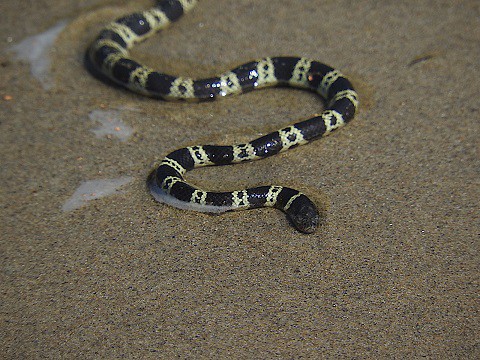
A common sea snake found in Australasia, which easily reaches 2 metres and may reach 2.6m. This is a venomous species with the usual paddle-shaped tail for powering effortlessly through water. Elegant sea snakes (Hydrophis elegans) can eat several food groups, but strongly lean towards snake eels, loving any elongated fish.
Rather than clinging frightenedly to coral reefs, this is one of the more flexible sea snakes. Elegant sea snakes can inhabit ocean depths of 80 metres, or even 145 metres. Yet they’re also at home in shallower waters, and have been found 12km upstream from the mouth of the Burnett river in Queensland. Elegant sea snakes are most common in shallow coastal waters off the northern coast of Australia, including Northern Territory and Queensland. They particularly like sea grass and mud flats at less than 3 metres in depth. One of their hotspots in Queensland is Cleveland Bay.
Elegant sea snakes are preyed on by sharks, namely the tiger shark, the main shark species to prey on sea snakes (great whites rarely bother). However, they have a keen ability to dodge. Scientists found in 2008 that Hydrophis elegans moves to the safety of seagrass beds whenever tiger sharks approach. These are inferior for their snake eel prey, yet are superior for camouflage. They usually spent time foraging on the open mudflats, yet abandoned them at high tide when tiger sharks had easier access.
| 2 | Slender-necked sea snake |
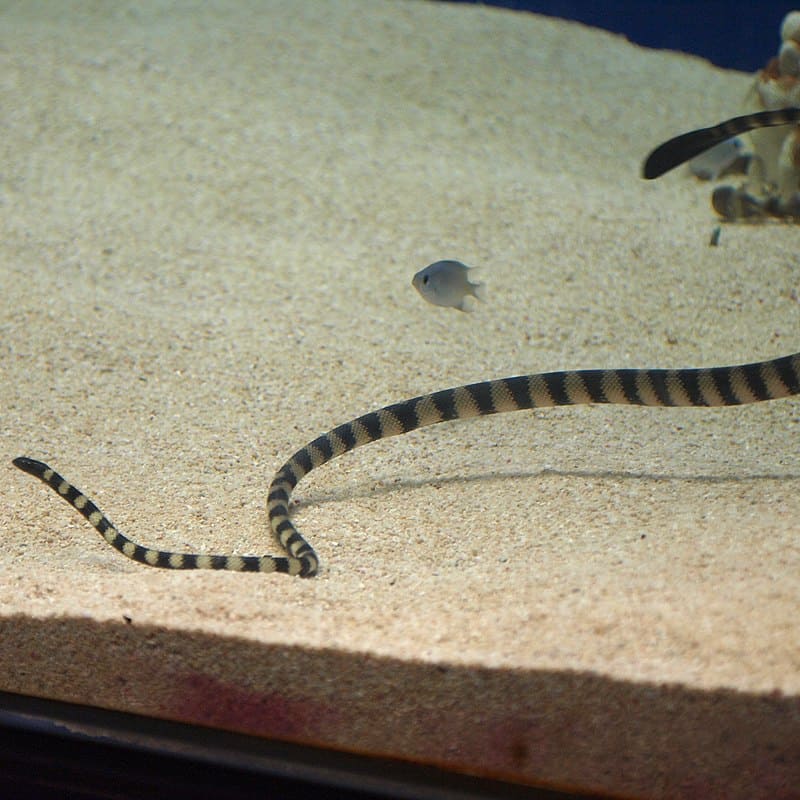
Hydrophis melanocephalus is another common sea snake which inhabits open seas, including offshore mudflats. This species lies further north: South China, southern Japan (Ryukyu Islands), and South Korea. It’s possible, but still being debated whether they live in Queensland. Either way, this sea snake likes cooler waters. Slender-necked sea snakes are often found on shallow mud flats between coral reefs, rather than prowling directly through them.
Hydrophis melanocephalus has a flexible diet, including sand divers and gobies, but eels are its favourite, including conger eels and burrowing eels. Slender-necked sea snakes can swallow an eel incredibly fast. One event was witnessed near Iriomote Island, southern Japan. The snake was pressing its head to the sea floor, until it suddenly whipped out a 30cm black-striped snake eel, from a hole invisible to human eyes. The sea snake floated to the surface, then commenced swallowing by the head, which it completed within 13 seconds.
Though fully aquatic like most Hydrophis members, Hydrophis melanocephalus can also swallow prey on land. It was witnessed swallowing a longfin snake eel, also near Iriomote Island, which was biting the sea snake painfully behind its head, but was still swallowed eventually. This happened on a muddy shore 3-4 metres from the water’s edge.
Slender-necked sea snakes are shorter than Hydrophis elegans. 1-1.2 metres is standard, with females slightly longer. One of its recognisable features is a yellowish streak behind the eye.
| 3 | Lambert’s sea snake |
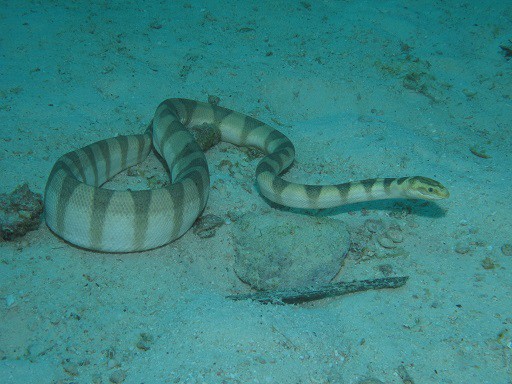
Lambert’s sea snake has the special feature of a large head, versus the short head of a Jerdon’s sea snake. This is a species of the gulf of Thailand, and is very common in certain spots, regularly scooped up by fish trawlers, and sometimes sold on for skin or food.
At first glance this is just another sea snake, but one of their signature features is a grey cap on their head, followed by an olive chin which extends across their belly. The shape of the bands is another key: they’re thicker along the spine, thinner on the flanks (see above). Male Lambert’s sea snakes beat females for size, at 122cm vs 104cm.
Hydrophis lamberti’s closest relative is the plain sea snake (Hydrophis inornatus). Singapore is another of their bases. If you want to meet Lambert’s sea snake yourself, then avoid coral reefs – they favour the sandy bottoms of the sea.
| 4 | Greater sea snake |
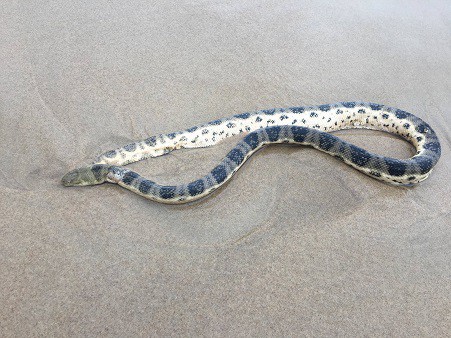
Alongside the elegant sea snake, Hydrophis major is the most commonly encountered sea snake in shallow coastal areas off northern Australia, away from coral reefs.
Like most Hydrophis members, this is a fully aquatic snake, unlike the banded sea krait which spends 50% of its time relaxing on rocky shores. The greater sea snake can move to deep water, but prefers shallow areas, particularly 1-2 metres deep, where they can blast through schools of eeltail catfish congregating together and grab them with ease. One hotspot for this sea snake is the New Caledonian port city of Noumea, also a hotspot for the turtle-headed sea snake.
At 80-100cm, it isn’t the longest sea snake, and females are longer than males. Hydrophis major has a strong taste for catfish, particularly eeltail catfish, which aren’t really eels but are elongated and slimy like they are. Hydrophis major has powerful neurotoxins to disable them, but life isn’t a cakewalk for them. A 2020 study found that in oceanic regions where greater sea snakes live, the eeltail catfish have significantly longer spines. This might be a highly focussed snake, as in New Caledonia coral reefs, the greater sea snakes eat eeltail catfish exclusively.
| 5 | Persian Gulf sea snake |
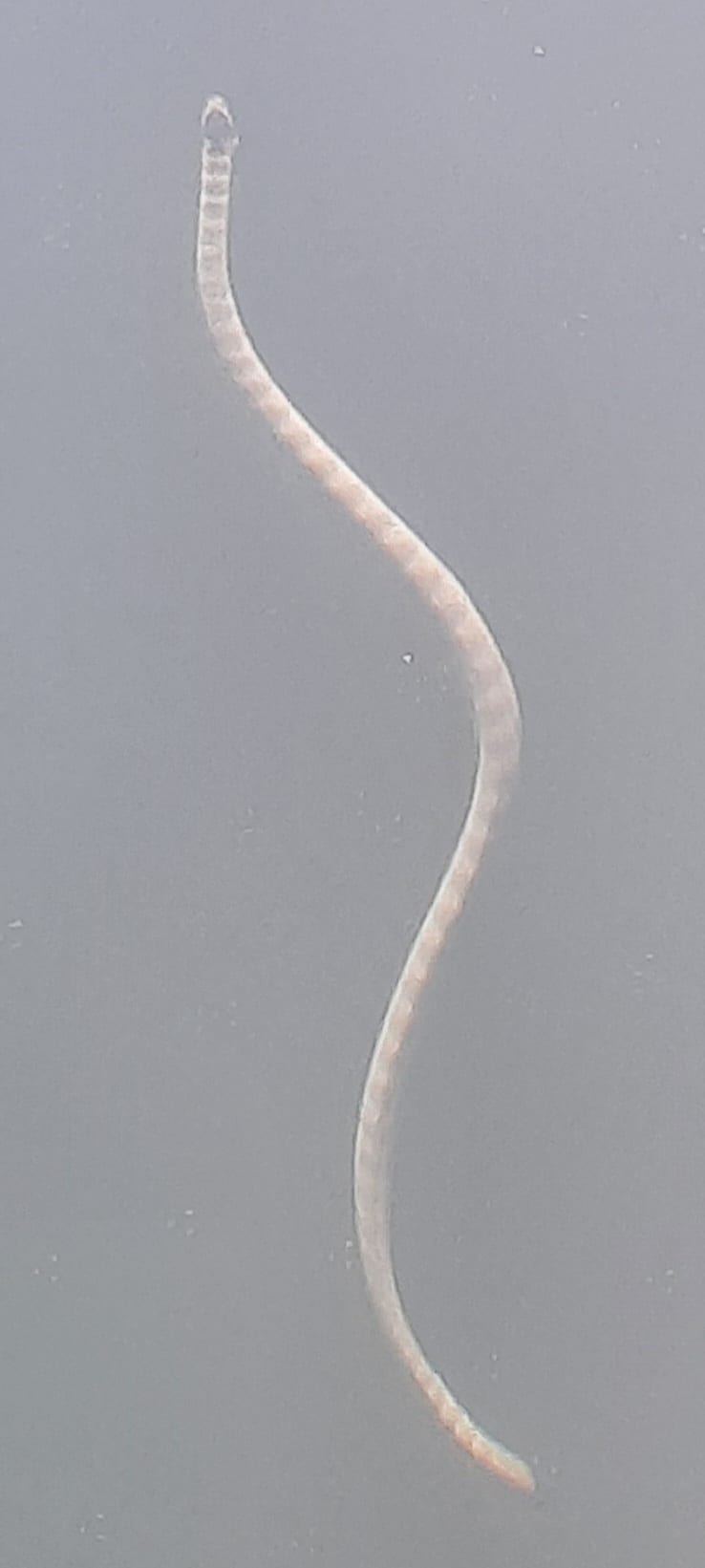
This is one of the shorter sea snakes, with a maximum of 96cm in males and 92.5cm in females. Hydrophis lapemoides stretches from the Oman coast, through India and Bangladesh and all the way to Thailand. It’s particularly common off the coast of United Arab Emirates, alongside the plain sea snake (Hydrophis inornatus).
Hydrophis lapemoides is fully aquatic, yet boasts the ability to move into freshwater estuaries temporarily as well. This is a shallow water species, moving through water 3 metres deep over coral reef and rocks. They constantly mingle with fishermen, some of whom are terrified, others learning to tolerate their presence decades ago.
Hydrophis lapemoides have a base colour of light grey or very pale yellow. These are overlaid with rings, normally black but sometimes with a greenish tint. The older the snake, the more these rings fade, and they’re also fainter on the belly. Their prey isn’t too specific: gobies, cardinalfish eels, flatfish, etc.
The Persian gulf sea snake has one interesting quirk: it gathers in hundreds or even thousands on the ocean surface. These gatherings are spotted by fishermen in the Arabian gulf. Yet when dolphin pods move into town, the sea snakes mysteriously disappear. The theory is that dolphins are natural predators of Hydrophis lapemoides.
| 6 | Jerdon’s sea snake |
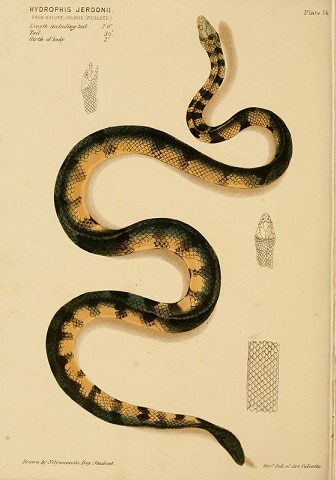
Hydrophis jerdonii lives off the east coast of the Indian subcontinent, but is one of the less abundant species. You won’t find hundreds swarming a single bay as fishermen try desperately to sail. It’s also found in the gulf of Siam east of Thailand, and the South China sea, including the southern coast of Vietnam.
Hydrophis jerdonii has a short head, and an olive base of colours with a slight green tinge. Compared to other sea snakes, its black bands are “blurry” – rather than sharply contrasting against the olive base, they fade in gradually. This is a medium sea snake which reaches a maximum of 100cm.
This sea snake is barely researched at all. Its existence isn’t in doubt, as scientists in boats surveying the gulf of Thailand see them every year. But barely anything is known about Hydrophis jerdoni’s diet, venom or oceanic adaptions, other than its usual paddle-shaped tail. They appear at least 12-20 miles off shore, as prawn trawlers have scooped them up there. Jerdon’s sea snake is sometimes sold for skins by people who accidentally catch them.
Originally, Jerdon’s sea snake was distinct enough from the pack to be part of its own family – Kerilia. But now it’s been moved back into Hydrophis mob after all.
| 7 | Annulated sea snake |
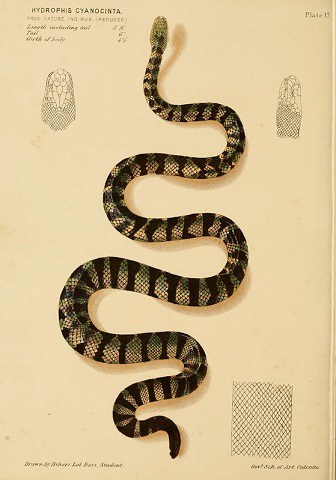
This species measures 120-160cm and is the most common sea snake in the waters of the Indian subcontinent. It can be found along the entire mainland coast of India, and its overall territory is equally vast. Annulated sea snakes appear from the Gulf of Persia, through India, to the Philippines and southern China. The one place they skip is Australia, as the competition with greater sea snakes is just too high. Annulated sea snakes prefer to control more northerly waters.
Though they prefer shallower waters, annulated sea snakes can be found up to 40km away from coastlines. Hydrophis cyanocinta is fairly aggressive for a sea snake, and is alert to its surroundings. They also move better on land than the majority of Hydrophis sea snakes. They skip coral reefs and instead inhabit muddy, sandy bottoms of seas, where they constantly search for fish.
Hydrophis cyanocinta has a mostly neurotoxic venom, but a 2021 study found that this varies by location. In Xisha, China, the venom consisted of 58.09% neurotoxins, compared to 81.1% in Hara, Iran. The theory was that prey was easier to obtain – that Hara had faster-moving fish which needed to be paralysed rapidly. The annulated sea snake’s diet is wider than the eel-fest of elegant sea snakes. It includes gobies like taileyed gobies, and especially mudskippers, including Indopacific slender mudskippers and Dussumier’s mudskippers.
| 8 | Yellow sea snake |
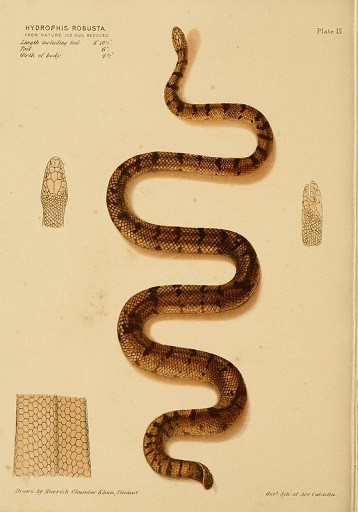
The yellow sea snake (Hydrophis spiralis) is believed to be the longest sea snake in the world, reaching a confirmed record of 2.75 metres, and averaging at over 2 metres. Yellow snakes were discovered in 1802, and are found along the coast of India, Sri Lanka and in the Persian Gulf. They favour deeper waters, usually below 10 metres, while surfacing regularly to warm themselves in the sun. Their diet is barely researched at all.
As usual, this is a venomous snake, and while nothing is proven, yellow sea snakes seem unusually aggressive compared to their fellows. A 2015 study found one off the coast of Kochi, southwest India, which was “very aggressive and showed a ready to bite”. This snake measured 2.3 metres, which is perfectly ordinary for this species.
Yellow snakes are recognisable by their yellow colour, and black bands which number 41-65. Its black rings are especially narrow compared to other sea snakes. The Iranian port town of Jask and the southeast Indian Tamil Nadu coast are hotspots for this species. By their very nature, sea snakes hard to research, particularly Hydrophis members which are fully aquatic. What we know about yellow sea snakes is mainly easily visible characteristics – its length, its bright colours, etc.
| 9 | Shaw’s sea snake |
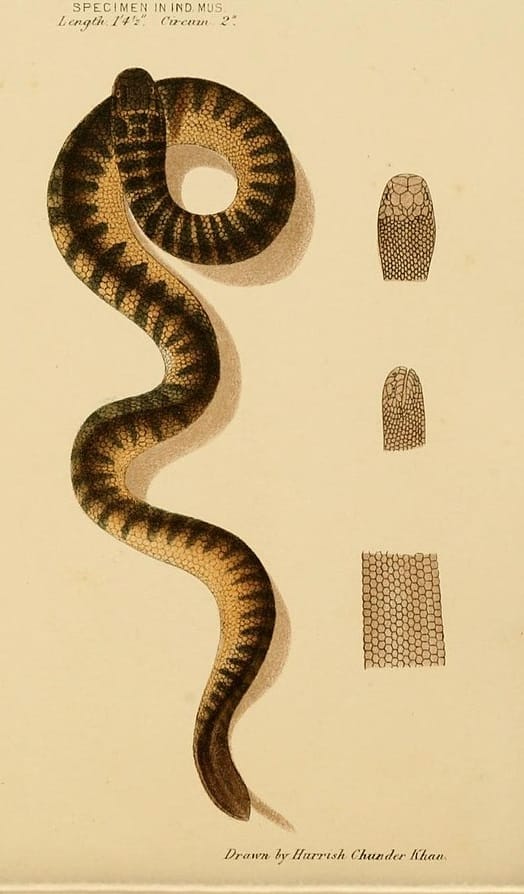
One of the most widespread sea snakes. Shaw’s sea snake (Hydrophis curtus) stretches from the Persian Gulf through India to the north coast of Australia. This snake lives in such a different world that it might as well be on another planet. It spends its days on the sandy bottoms of seas in ambush posture, waiting for subtle water movements that indicate an oncoming fish. If a goby brushes against its scales, then Shaw’s sea snake will instantly strike and devour, unless the fish weaves out of the way.
Shaw’s sea snake measures 90cm, and is one of the thicker sea snakes. They have weirdly baggy belly scales, and blurry, indistinct banded patterns.
One study compared Hydrophis curtus directly to the elegant sea snake, in Australian waters. It found that Hydrophis curtus preferred locations further from freshwater (at least 3km) such as river estuaries. It liked seagrass beds, but slightly deeper ones, at up to 4 metres vs less than 3 metres. The elegant sea snake was highly specific in its diet, targeting eels, while Shaw’s sea snake chose from 4 families of fish (gobies, jacks, pomfreys). This is a flexible sea snake, and that’s probably why it’s so common.
Hydrophis curtus has an extremely high density of blood vessels in its skin, which is thought to be for underwater oxygen absorption. There were so many blood vessels that scientists couldn’t make an incision without extremely heavy bleeding. They also have an incredibly hard skull capsule which made it almost impossible for scientists to analyse their brain tissue.
| 10 | Belcher’s sea snake |
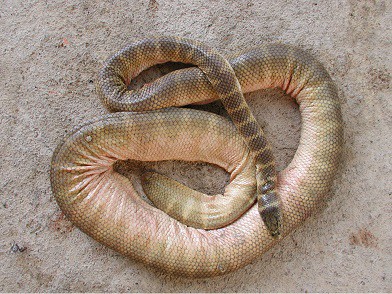
A sea snake with a simple claim to fame: the deadliest. In fact, Belcher’s sea snake (Hydrophis belcheri) was once estimated to wield the deadliest snake venom in the world, except that different testing systems (intramuscular, intravenous etc) were incorrectly lumped together. The LD50 toxicity rating was actually 0.24mg, versus 0.025mg for an inland taipan. Nevertheless, Belcher’s sea snake still generates monstrously powerful neurotoxins which totally deactivate human brain signals. This species measures 100cm and lives from New Guinea to southeast Asia. Belcher’s sea snake appears in the Java sea and Gulf of Thailand alike. They mainly skip Australia, with the exception of Ashmore reef in the Arafura sea.
Elsewhere, they’re fairly normal. They have a flattened tail for swishing water out of the way, cutting through the ocean surface. From a distance, they have the standard black bands of most sea snakes, overlaid on white or pale olive. However, they have yellowish markings around the eye that others lack.
Belcher’s sea snake remains mysterious in many ways. In 2000, they were discovered off the Vietnamese coast for the first time. Belcher’s sea snake has a very timid temperament, and will only bite if severely pressured.
